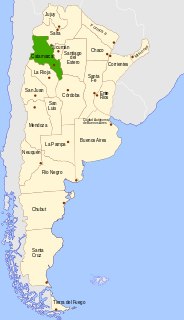
Catamarca is a province of Argentina, located in the northwest of the country. The province had a population of 334,568 as per the 2001 census [INDEC], and covers an area of 102,602 km2. Its literacy rate is 95.5%. Neighbouring provinces are : Salta, Tucumán, Santiago del Estero, Córdoba, and La Rioja. To the west it borders the country of Chile.

Tucumán is the most densely populated, and the second-smallest by land area, of the provinces of Argentina. Located in the northwest of the country, the province has the capital of San Miguel de Tucumán, often shortened to Tucumán. Neighboring provinces are, clockwise from the north: Salta, Santiago del Estero and Catamarca. It is nicknamed El Jardín de la República, as it is a highly productive agricultural area.
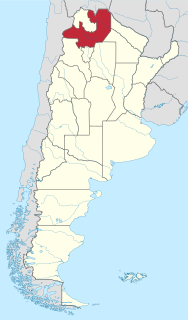
Salta is a province of Argentina, located in the northwest of the country. Neighboring provinces are from the east clockwise Formosa, Chaco, Santiago del Estero, Tucumán and Catamarca. It also surrounds Jujuy. To the north it borders Bolivia and Paraguay and to the west lies Chile.
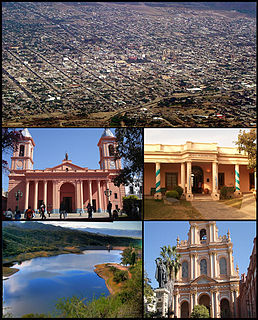
San Fernando del Valle de Catamarca is a city in northwestern Argentina and capital of Catamarca Province, on the Río Valle River, at the feet of the Cerro Ambato. The city name is normally shortened as Catamarca.

Santiago del Estero is the capital of Santiago del Estero Province in northern Argentina. It has a population of 252,192 inhabitants, making it the twelfth largest city in the country, with a surface area of 2,116 km². It lies on the Dulce River and on National Route 9, at a distance of 1,042 km north-northwest from Buenos Aires. Estimated to be 455 years old, Santiago del Estero was the first city founded by Spanish settlers in the territory that is now Argentina. As such, it is nicknamed "Madre de Ciudades". Similarly, it has been officially declared the "mother of cities and cradle of folklore."
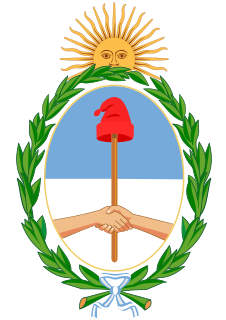
Departments form the second level of administrative division, and are subdivided in municipalities. They are extended in all of Argentina except for the Province of Buenos Aires and the Autonomous City of Buenos Aires, the national capital, each of which has different administrative arrangements.

La Paz is a department located in the south of Catamarca Province in Argentina.

The Central Northern Railway was the first 1,000 mm railway built by the Argentine State Railway. Its aim was to extend the existing British-owned Central Argentine 5 ft 6 in railway from Córdoba to Tucuman and metre gauge was chosen for economic reasons.

Recreo is a city in Catamarca Province, Argentina. It is the head town of the La Paz Department. Recreo is also referred to the name of the Carts Recreo.
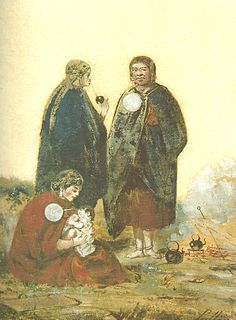
Argentina has 35 indigenous groups according to the Complementary Survey of the Indigenous Peoples of 2004, the Argentine government's first attempt in nearly 100 years to recognize and classify the population according to ethnicity. In the survey, based on self-identification or self-ascription, around 600,000 Argentines declared to be Amerindian or first-generation descendants of Amerindians, that is, 1.49% of the population. The most populous indigenous groups were the Aonikenk, Kolla, Qom, Wichí, Diaguita, Mocoví, Huarpe peoples, Mapuche and Guarani In the 2010 census [INDEC], 955,032 Argentines declared to be Amerindian or first-generation descendants of Amerindians, that is, 2.38% of the population. Many Argentines also identify as having at least one indigenous ancestor; a genetic study conducted by the University of Buenos Aires in 2011 showed that more than 56% of the 320 Argentines sampled were shown to have at least one indigenous ancestor in one parental lineage and around 11% had indigenous ancestors in both parental lineages.
Cacán is an extinct language that was spoken by the Diaguita and Calchaquí tribes in northern Argentina and Chile. It became extinct during the late 17th century or early 18th century. The language was documented by the Jesuit Alonso de Bárcena, but the manuscript is lost. Genetic affiliation of the language remains unclear, and due to the extremely limited number of known words, it has not been possible to conclusively link it to any existing language family.

Tafí del Valle is a city in Tucumán, Argentina. It is located in the department of the same name, of which it is the main settlement, in the west of the Argentine province of Tucumán, 126 km from the provincial capital, San Miguel de Tucumán.
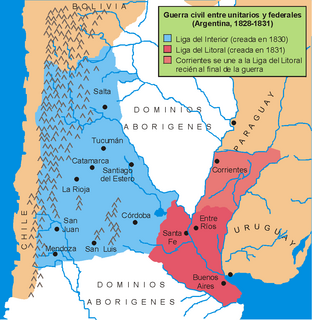
The Unitarian League also referred to as the League of the Interior was a league of provinces of Argentina led by José María Paz, established in 1830, aiming to unite the country under unitarian principles. It comprised the provinces of San Luis, La Rioja, Catamarca, Mendoza, San Juan, Tucumán, Córdoba, Salta and Santiago del Estero. It was opposed and ultimately defeated by the provinces of the Federal Pact.

File:General Gregorio Paz.jpg
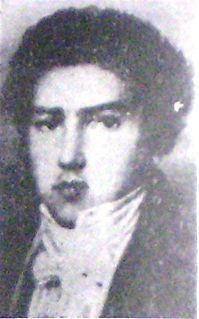
Marco Manuel Avellaneda was the governor of Tucumán Province in Argentina, and father of the Argentine President Nicolás Avellaneda. He was executed after an unsuccessful revolt against the Federal government, and his head was displayed on a pike.
Francisco Javier López was an Argentine soldier, a leader in the Unitarian Party and several times Governor of Tucumán Province.

Juan Felipe Ibarra was an Argentine soldier and politician. He was one of the caudillos who dominated the Argentine interior during the formation of the national state, and ruled the province of his birth for decades.
Martín Yanzón was an Argentine soldier and caudillo who died fighting against the supporters of the dictator Juan Manuel de Rosas.
The department of Tafí Viejo is a department of the province of Tucumán (Argentina), created in 1907 by the reform of the provincial constitution, which divided the old department Tafí. Its head is the homonymous city. Bordered on the north by the department Trancas, east to Burruyacú and Cruz Alta, south of Capital, Yerba Buena and Lules, and west to Tafí del Valle.














